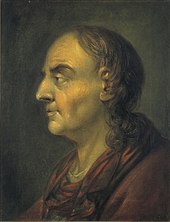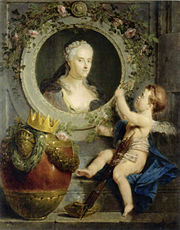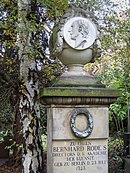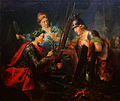Bernhard Rode


Christian Bernhard Rode (born July 25, 1725 in Berlin , † June 28, 1797 in Berlin) was a Berlin history painter in the second half of the 18th century. He was one of the most important artists of the Frederician Rococo and was closely connected to the leading personalities of the Berlin Enlightenment and to their ideas, which he sought to spread through his works.
Biographical
Apprenticeship and travel years
Rode was the son of the goldsmith Christian Bernhardt Rode and his wife Anna Sophie. The engraver Johann Heinrich Rode and the art potter Philipp Rode were his brothers. Bernhard received the earliest artistic instruction from his father, the first drawing instruction from an otherwise little-known painter named N. Müller. The four-year training in the workshop of the court painter Antoine Pesne , at that time the most influential painter in Berlin and Brandenburg , was important for his professional development . During this apprenticeship, portrait painting was the focus. In 1748 Rode began a study trip lasting several years. In Paris he worked for 18 months in the workshops of Jean Restout and Charles André van Loo (also known as Carle van Loo or Vanloo), he met Jean-Baptiste Deshayes and developed his inclination for history painting. He studied the old masters in Venice and Rome. In 1755 or 1756 he returned to Berlin. Only a few of his works are known from these early years.
live in Berlin

The painter married in 1757 and his wife Sophie Luise remained childless. Thanks to an annuity from his father's assets, Rode was financially independent - a peculiarity at the time when artists almost always spent their professional lives directly dependent on their clients. Rode, on the other hand, was largely able to determine the working techniques, formats and themes of his works himself. He could afford to give away pictures - rural churches in Brandenburg received altarpieces from him, and his own parish received four paintings that are still in the Marienkirche in Berlin-Mitte . Because he found the teaching in the Academy of the Arts (at that time still "Royal Prussian Academy of Arts and Mechanical Sciences") under its director Blaise Nicolas Le Sueur completely inadequate, he set up a private drawing room in his house, which Daniel Chodowiecki also used visited regularly.
Rode had serious health problems from around 1785, but remained artistically active until shortly before his death. In 1797 he was buried in the Schützenkirchhof, the cemetery of the St. Nikolai and St. Mary parishes in the Berlin royal city . When the centrally located, small cemetery was abandoned and built over, Rode was given a grave in the newly laid out St. Marien and St. Nikolai Cemetery I on Prenzlauer Allee ; In 1852 the Akademie der Künste provided a tomb with a portrait medallion. The grave has been dedicated to the city of Berlin as an honor grave since 1994 .
Friend of the Berlin scouts

Since around 1750, the center of the Berlin Enlightenment was a learned society of friends around the publisher and writer Friedrich Nicolai - the poet and philosopher Karl Wilhelm Ramler , the philosophers Johann Georg Sulzer and Thomas Abbt, and at times Gotthold Ephraim Lessing and Moses Mendelssohn . They turned to citizens with scientific and literary interests, open to the goals of bourgeois emancipation , but at the same time loyal and patriotic towards the state of Prussia and its king. The combination of civic enlightenment and patriotism resulted in efforts to promote national education, the promotion of German language and literature, German art and an appreciation of history. Bernhard Rode did not belong directly to the group of humanities scholars, but was friends with some of them. He made the goals and suggestions developed here the basis of his work.
Karl Wilhelm Ramler was one of Rode's close friends. Above all, his influence led him to make the history of Brandenburg and Prussia an essential subject of his art. In doing so, he followed the view of the Enlightenment, according to which history should not be understood one-dimensional, but as a complex reality. Not only the rulers, but also their subjects belonged to the picture of history as well as all historical epochs, including the Middle Ages , which had been neglected up until then . Rode used the “ General Theory of Fine Arts ” as a philosophical guideline , the author of which Johann Georg Sulzer clearly assigned educational tasks to art and demanded that every artist face this responsibility. Sulzer praised Rode's work for the "feelings of righteousness and general honesty, true honor, the love of the fatherland, freedom, humanity ..." .
At the Academy of Arts
From 1756 Rode was a member of the Berlin Academy of the Arts . In 1783 he was appointed director of the academy to succeed Le Sueur. His long-time friend Daniel Chodowiecki, also a member of the academy, had strongly supported the appointment. He and his colleagues at the Academy hoped that this change to revitalize the institution that had lost in previous decades in importance - the economical "Soldier King" Frederick William I had little interest in art and culture, his successor Friedrich II. ( Frederick the Great) was based almost exclusively on French models. Despite repeated petitions to the king in an attempt to win him over to reorganizing the academy, Rode was unable to achieve anything substantial. Finally, Chodowiecki himself took on important posts at the academy. He played a key role in its reform of 1790, now under the rule of Friedrich Wilhelm II . In 1797, after Rode's death, he was his successor to the post of director.
The Emperor of China pulls the first furrow in honor of agriculture , around 1770, formerly Gut Britz
The Empress of China picking the first mulberry leaves to honor the silk industry , around 1770, formerly Gut Britz
Odysseus recognized by his dog after his return , around 1778, Gut Neuhaus
Scene from the life of Tamerlans , 1781/82, Gut Neuhaus
A negro sucks the snake venom out of the wound of his English master , 1782, Gut Neuhaus
The artistic work
overview

Rode's oeuvre shows an unusual versatility of artistic techniques. This includes wall and ceiling paintings , but also panel paintings , etchings , book illustrations and design drawings for reliefs . His work was not judged uniformly: Experts accused him of volatility in the work process and defects in the drawing; It was also criticized that he repeatedly used stereotyped figures and faces once he had developed - an expression of the fact that in the large number of his works, dealing with content was ultimately more important to him than formal questions. Rode met with great approval for his subjects and for his moral and educational intentions. He used motifs from the Old Testament , Greek and Roman mythology , history from the Middle Ages to current events of his time, and from contemporary literature. In many cases there were no role models for the implementation of his specific historical and literary themes. The more precise interpretation of his work therefore required knowledge that he could only occasionally take for granted in his bourgeois audience, that he wanted to spread or deepen first of all.
The majority of all wall and ceiling paintings were destroyed in the Second World War. In addition, several panel paintings from former private property, as well as a number of altarpieces, have been considered lost since then. However, many of Rode's work have been preserved. They are kept in the Foundation City Museum Berlin , the Picture Gallery of the State Museums , the Foundation Prussian Palaces and Gardens Berlin-Brandenburg . Larger holdings of the graphic work are owned by the Veste Coburg , the Kunsthalle Kiel and the Germanic National Museum in Nuremberg .
Wall and panel paintings

Rode created wall and ceiling pictures for the New Palace and the Marble Palace in Potsdam as well as for various rooms in the Berlin City Palace . The training given by Antoine Pesne, the Rococo painter, could still be recognized in these non-preserved works, in their light colors and the typical, purely decorative variations on ancient themes . Between 1776 and 1782, a cycle of pictures for Count von Hahn was created at Gut Neuhaus in Schleswig-Holstein ; here the transition to thematically more demanding history painting becomes visible. From 1770 to 1772 Rode had already furnished the manor house at Gut Britz ( Schloss Britz ) near Berlin for Count Ewald Friedrich von Hertzberg with wall and ceiling paintings, in which he programmatically addressed an idealized connection between statesman and farmer using historical pictures. He may also have painted the garden room in the manor house in Groß Kreutz (Havel) built in 1765 .
Most of the panel paintings, portraits and altarpieces were stylistically based on the work of the Dutch baroque painter and draftsman Rembrandt van Rijn . The pictures were mainly dark, their coloring largely reduced to shades of gray and brown. When they darkened over time, they became almost unrecognizable. This is what happened to the altarpieces in St. Mary's Church, which were created between 1755 and 1762; their themes, biblical stories such as " The Unbelieving Thomas " or " The Disciples of Emmaus ", were depicted by Rode in the spirit of the Enlightenment less religiously and rather profane historically.
Rode's most important historical pictures include the "Brandenburgiana", a cycle of 14 paintings about significant events in Brandenburg history, which was completed in 1763. The individual motifs are taken from Frederick the Great's “Memoires pour servir à l'Histoire de la maison de Brandenbourg” (“Memories of the House of Brandenburg”). Seven further, complementary pictures, the so-called "Fridericiana", were created after the death of the king , who was highly revered by the artist.
Allegory about Frederick the Great as the founder of the German Prince League , 1786
Frederick the Great as Perseus , 1789 - Allegory of the beginning of the Seven Years' War
Frederick the Great before the Battle of Torgau , 1791
Frederick the Great after the Battle of Torgau , probably 1793
Frederick the Great on the dam to Lissa , probably 1793 - lost in the war
The occupation of the Polish lands by Frederick the Great , 1796
For the Berlin garrison church , Rode delivered five “hero pictures” in memory of Prussian generals. After 1759 he first painted four allegorical- patriotic depictions of military leaders who had died shortly before in the Seven Years' War . A fifth painting was dedicated to Hans Joachim von Zieten and was created after his death in 1786. Theodor Fontane later wrote about this : “The composition of this picture too is a work of the dozen and […] actually without a spirit. Here, too, a comfortable operation with traditional remedies and arrangements. An urn with the relief image of Zietens in the front of the same, on the bottom a lion, which is quite peacefully in a Zieten's hussar tiger blanket like a tomcat in a lady's muff - also a tall woman who presses a wreath of stars onto the urn - that's all. “ All five pictures were lost in a fire in 1908, copies were destroyed in World War II.
Etchings and Illustrations
The approximately 300 etchings form an important complex in Rode's oeuvre. As a technique - which he since the early 1750s autodidactically appropriated - he used the etching in multiple stages. Later he occasionally gave up this method by etching the main motifs, but treating other areas, mostly the backgrounds, as drypoint etchings. Again he oriented himself on Rembrandt, now especially on his etchings, which were still very popular in the 18th century. Sometimes an etching served as a preliminary stage for a painting. More often, he later transferred his paintings to this technique in order to make motifs that were important to him accessible to a larger group of customers at a reasonable price. One of Rode's most popular works was a series of etchings after the masks of dying warriors, which Andreas Schlueter had made as keystones for the windows in the inner courtyard of the Berlin armory . The book edition from 1759 was entitled "Larvae drawn according to the models of the famous Schlueter and etched in copper by B. Rode". In 1763, the work “Les Actions Glorieuses de Frédéric Le Grand” (“The Glorious Deeds of Frederick the Great”) was published in Berlin - 30 large-format engravings for which Rode had drawn the templates. With a series of etchings he also illustrated the "fables" of the moral philosopher and writer Christian Fürchtegott Gellert .
Between 1779 and 1784 the “General World History for Children” appeared in four parts , edited by Johann Matthias Schröckh in Leipzig and illustrated by Bernhard Rode. His drawings corresponded in their pedagogical attitude to the needs and abilities of the children: They were focused on the essentials of an action, children were often the focus of the action, the depiction of cruelty was avoided whenever possible, as well as idealizing allegories in the Rococo style. With this work, Rode provided an example of the illustration of history books, which served as a model well into the 19th century.
Mask of a dying warrior based on Schlueter , 1759
Emperor Heinrich IV jumps from the ship of his kidnapper , the Archbishop of Cologne , etching, 1781
The charcoal burner defends the stolen Saxon prince , etching, 1781
architectural art
Since 1786, together with the architect Carl Gotthard Langhans , he has been developing designs for decorative reliefs, intended for various building projects by the new King Friedrich Wilhelm II. His drawn proposals were used in the Berlin City Palace and the Potsdam Marble Palace. The bas-relief "Triumph of Peace", which was attached around 1793 directly below the goddess of victory and Quadriga on the east side of the Brandenburg Gate , is also based on Rode's preparatory work.

Gallery of Etchings
Biblical
Abraham wants to sacrifice his son , around 1776
The Resurrection of the Dead and the Last Judgment , 1767/79
Antique
An augur declares Numa Pompilius to be king after the oracle of the flight of birds , 1768/69
Socrates in conversation with his friends before death , 1776
Diogenes with the lantern in the market , around 1775
The Magnanimity of Scipio Africanus , 1779
Herod destroys a band of robbers , 1779
Medieval
Rudolph , counter-emperor Heinrich IV. Loses his arm in the meeting , 1781
Henry the Lion conquers the Wends , 1781
The young Konradin kisses the head of his friend who has been beheaded before him , 1781
Instead of the scepter, Rudolph takes the crucifix as a tribute , 1782
Johannes Hus at the stake , around 1781
Brandenburgiana
Albrecht Achilles first climbed the walls of Greiffenberg , 1783
Joachim II takes Holy Communion in Both Forms , 1783
Friedrich Wilhelm the Great leads his infantry on sledges across the Fresh Lagoon , 1679 , around 1783
Contemporaries
Kleist , medallion on the sarcophagus, crowned by the goddess of friendship , 1774
Schwerin , falling and embracing victory , around 1777
AD Therbusch born v. Lisiewska , b. 1722, d. 1782 , around 1782
Klio , 1792 - missing
literature
- Helmut Börsch-Supan : The art in Brandenburg-Prussia. Their history from the Renaissance to the Biedermeier period, shown in the art collection of the Berlin palaces . Verlag Mann, Berlin 1980, ISBN 3-7861-1273-8 .
- Helmut Börsch-Supan / Claudia Pryzborowski: Christian Bernhard Rode and the furnishings of Hertzberg's country house in Britz. In: 300 years of Britz Castle. Ewald Friedrich Graf von Hertzberg and the Berlin Enlightenment . Berlin 2006. ISBN 978-3-00-018846-6 .
- Anton F. Büsching : Description of his journey from Berlin via Potsdam to Rekahn not far from Brandenburg, which he made from June 3rd to 8th 1775 . Frankfurt and Leipzig 1780.
- Frank Büttner (Hrsg.): Art in the service of the Enlightenment. Etchings by Bernhard Rode . Kunsthalle, Kiel 1986, ISBN 3-923701-17-9
- Herbert von Eine: German painting of classicism and romanticism 1760-1840 . Beck, Munich 1979, ISBN 3-406-03206-0
- Renate Jacobs: The graphic work of Bernhard Rodes . LIT-Verlag, Münster 1990, ISBN 3-88660-643-0
- Gisold Lammel: Daydreams. Images in the light of the Enlightenment . Verlag der Kunst, Dresden 1993, ISBN 3-364-00263-0
- Rainer Michaelis: Fridericiana. Christian Bernhardt Rode (1725–1797) . National Museums in Berlin Prussian Cultural Heritage, Berlin 1999, ISBN 3-88609-376-X
- Friedrich Nicolai: Description of the royal residence cities of Berlin and Potsdam, of all the peculiarities located there and the surrounding area . Berlin 1786.
- Dorothee Ritter: Rode, Christian Bernhardt. In: New German Biography (NDB). Volume 21, Duncker & Humblot, Berlin 2003, ISBN 3-428-11202-4 , p. 690 f. ( Digitized version ).
- Weinitz: Rode, Christian Bernhard . In: Allgemeine Deutsche Biographie (ADB). Volume 29, Duncker & Humblot, Leipzig 1889, p. 3 f.
Web links
- Literature by and about Bernhard Rode in the catalog of the German National Library
- A biographical text by Gerhild Komander.
- Rode in connection with the Berlin Enlightenment, a text by Gerhild Komander.
Individual evidence
- ^ Johann Georg Sulzer: General Theory of Fine Arts, Vol. 1–4, reprint of the 2nd edition, Leipzig 1792, Hildesheim 1970, Vol. 2, p. 53 ff.
- ↑ This view is held by Prof. Dr. Hans Kania in: The manor house of Groß-Kreutz , Märkischer Heimatkalender for the Zauche from 1928, pp. 34–38
- ↑ Archive link ( Memento from April 18, 2009 in the Internet Archive )
- ↑ MDZ reader | Band | General world history for children / Schröckh, Johann Matthias | General world history for children / Schröckh, Johann Matthias. Retrieved January 10, 2019 .
| personal data | |
|---|---|
| SURNAME | Rode, Bernhard |
| ALTERNATIVE NAMES | Rode, Christian Bernhard (full name) |
| BRIEF DESCRIPTION | German painter |
| DATE OF BIRTH | July 25, 1725 |
| PLACE OF BIRTH | Berlin |
| DATE OF DEATH | June 28, 1797 |
| Place of death | Berlin |













































